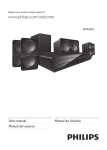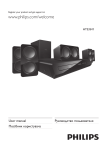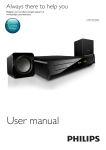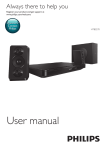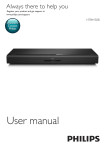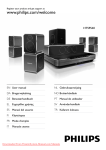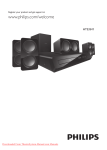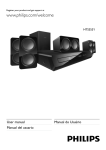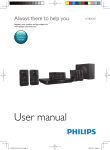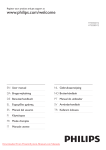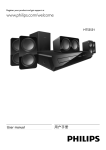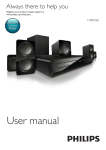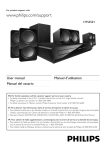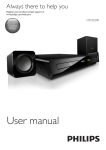Download Philips HTS3541 User's Manual
Transcript
Always there to help you Register your product and get support at www.philips.com/welcome Question? Contact Philips User manual HTS3541 Contents 1 Notice Copyright Compliance Mains fuse (UK only) Open source software Trademarks 2 Important Safety Care for your product Care of the environment 3 Your home theater Main unit Remote control 4 Connect your home theater Speakers Connectors Connect to TV Connect audio from TV and other devices Internet 3 3 3 3 3 3 7 Update software 8 Product specifications 29 5 5 6 6 9 Troubleshooting 32 10 Index 34 7 7 7 9 9 10 11 12 13 5 Use your home theater 15 15 16 18 18 19 20 21 21 6 Change settings 23 23 23 24 25 25 26 Choose sound Discs USB storage devices DivX Audio, video, and picture options Radio MP3 player EasyLink Picture Sound Language Parental control Energy saving Apply factory settings 27 Check software version 27 Update software through the Internet 27 Update software through USB 27 EN 2 1Notice This section contains the legal and trademark notices. • the ASTA approval mark. Contact your dealer if you are not sure about what type of fuse to use. Caution: To conform with the EMC directive (2004/108/EC), do not detach the plug from the power cord. Copyright Open source software This item incorporates copy protection technology that is protected by U.S. patents and other intellectual property rights of Rovi Corporation. Reverse engineering and disassembly are prohibited. Copyright in the UK Recording and playback of material may require consent. See Copyright Act 1956 and The Performers Protection Acts 1958 to 1972. Compliance This product is in compliance with the essential requirements and other relevant provisions of Directives 2006/95/EC (Low Voltage), 2004/108/EC (EMC). Mains fuse (UK only) This information applies only to products with a UK mains plug. This product is fitted with an approved molded plug. If you replace the fuse, use one with: • the ratings shown on the plug, • a BS 1362 approval, and 3 EN Philips Electronics Singapore Pte Ltd hereby offers to deliver, upon request, a copy of the complete corresponding source code for the copyrighted open source software packages used in this product for which such offer is requested by the respective licenses. This offer is valid up to three years after product purchase to anyone in receipt of this information. To obtain source code, please contact open. [email protected]. If you prefer not to use email or if you do not receive confirmation receipt within a week after mailing to this email address, please write to "Open Source Team, Philips Intellectual Property & Standards, P.O. Box 220, 5600 AE Eindhoven, The Netherlands". If you do not receive timely confirmation of your letter, please email to the email address above. The texts of the licenses and acknowledgements for open source software used in this product are included on a separate leaflet. Trademarks "Blu-ray Disc", "Blu-ray" and "Blu-ray Disc" logo are trademarks of Blu-ray Disc Association. Java and all other Java trademarks and logos are trademarks or registered trademarks of Sun Microsystems, Inc. in the United States and/or other countries. Manufactured under license under U.S. Patent Nos: 5,956,674; 5,974,380; 6,226,616; 6,487,535; 7,392,195; 7,272,567; 7,333,929; 7,212,872 & other U.S. and worldwide patents issued & pending. DTS-HD, the Symbol, & DTSHD and the Symbol together are registered trademarks & DTS-HD Master Audio | Essential is a trademark of DTS, Inc. Product includes software. DTS, Inc. All Rights Reserved. software tools to convert your files into DivX video. ABOUT DIVX VIDEO: DivX® is a digital video format created by DivX, LLC, a subsidiary of Rovi Corporation. This is an official DivX Certified® device that plays DivX video. Visit divx.com for more information and software tools to convert your files into DivX videos. ABOUT DIVX VIDEO-ON-DEMAND: This DivX Certified® device must be registered in order to play purchased DivX Video-onDemand (VOD) movies. To obtain your registration code, locate the DivX VOD section in your device setup menu. Go to vod.divx.com for more information on how to complete your registration. HDMI, the HDMI logo, and High-Definition Multimedia Interface are trademarks or registered trademarks of HDMI licensing LLC in the United States and other countries. CLASS 1 LASER PRODUCT Manufactured under license from Dolby Laboratories. Dolby and the double-D symbol are trademarks of Dolby Laboratories. Covered by one or more of the following U.S. patents: 7,295,673; 7,460,668; 7,515,710; 7,519,274. DivX®, DivX Certified®, DivX Plus® HD and associated logos are trademarks of Rovi Corporation or its subsidiaries and are used under license. ABOUT DIVX PLUS® HD: DivX® is a digital video format created by DivX, Inc. This is an official DivX Certified® device that plays DivX video, including DivX® Plus HD video (H.264/. MKV) up to 1080p and premium content. Visit www.divx.com for more information and EN 4 2Important Read and understand all instructions before you use your home theater. If damage is caused by failure to follow instructions, the warranty does not apply. Safety Risk of electric shock or fire! • Never expose the product and accessories to rain or water. Never place liquid containers, such as vases, near the product. If liquids are spilt on or into the product, disconnect it from the power outlet immediately. Contact Philips Consumer Care to have the product checked before use. • Never place the product and accessories near naked flames or other heat sources, including direct sunlight. • Never insert objects into the ventilation slots or other openings on the product. • Where the mains plug or an appliance coupler is used as the disconnect device, the disconnect device shall remain readily operable. • Disconnect the product from the power outlet before lightning storms. • When you disconnect the power cord, always pull the plug, never the cable. Risk of short circuit or fire! • Before you connect the product to the power outlet, ensure that the power voltage matches the value printed on the back or bottom of the product. Never connect the product to the power outlet if the voltage is different. Risk of injury or damage to the home theater! • For wall-mountable products, use only the supplied wall mount bracket. Secure the wall mount to a wall that can support the combined weight of the product and the 5 EN • • • • • • wall mount. Koninklijke Philips Electronics N.V. bears no responsibility for improper wall mounting that results in accident, injury or damage. For speakers with stands, use only the supplied stands. Secure the stands to the speakers tightly. Place the assembled stands on flat, level surfaces that can support the combined weight of the speaker and stand. Never place the product or any objects on power cords or on other electrical equipment. If the product is transported in temperatures below 5°C, unpack the product and wait until its temperature matches room temperature before connecting it to the power outlet. Visible and invisible laser radiation when open. Avoid exposure to beam. Do not touch the disc optical lens inside the disc compartment. Parts of this product can be made of glass. Handle with care to avoid injury and damage. Risk of overheating! • Never install this product in a confined space. Always leave a space of at least four inches around the product for ventilation. Ensure curtains or other objects never cover the ventilation slots on the product. Risk of contamination! • Do not mix batteries (old and new or carbon and alkaine, etc.). • Danger of explosion if batteries are incorrectly replaced. Replace only with the same or equivalent type. • Remove batteries if they are exhausted or if the remote control is not to be used for a long time. • Batteries contain chemical substances, they should be disposed of properly. Risk of swallowing batteries! • The product/remote control may contain a coin/button type battery, which can be swallowed. Keep the battery out of reach • • • of children at all times! If swallowed, the battery can cause serious injury or death. Severe internal burns can occur within two hours of ingestion. If you suspect that a battery has been swallowed or placed inside any part of the body, seek immediate medical attention. When you change the batteries, always keep all new and used batteries out of reach of children. Ensure that the battery compartment is completely secure after you replace the battery. If the battery compartment cannot be completely secured, discontinue use of the product. Keep out of reach of children and contact the manufacturer. This is CLASS II apparatus with double insulation, and no protective earth provided. Care for your product • • • • Do not insert any objects other than discs into the disc compartment. Do not insert warped or cracked discs into the disc compartment. Remove discs from the disc compartment if you are not using the product for an extended period of time. Use only microfiber cloth to clean the product. When this crossed-out wheeled bin symbol is attached to a product it means that the product is covered by the European Directive 2002/96/ EC. Please inform yourself about the local separate collection system for electrical and electronic products. Please act according to your local rules and do not dispose of your old products with your normal household waste. Correct disposal of your old product helps to prevent potential negative consequences for the environment and human health. Your product contains batteries covered by the European Directive 2006/66/EC, which cannot be disposed with normal household waste. Please inform yourself about the local rules on separate collection of batteries because correct disposal helps to prevent negative consequences for the environmental and human health. Care of the environment Your product is designed and manufactured with high quality materials and components, which can be recycled and reused. EN 6 3 Your home theater 1 2 Congratulations on your purchase, and welcome to Philips! To fully benefit from the support that Philips offers, register your home theater at www.philips.com/welcome. 3 14 4 15 Main unit 6 5 7 8 16 17 9 a Disc compartment b Display panel c (Open/Close) Open or close the disc compartment, or eject the disc. d (Play/Pause) Start, pause or resume play. 18 10 11 12 13 (Standby-On) Switch the home theater on or to standby. Remote control a (Standby-On) • Switch the home theater on or to standby. • When EasyLink is enabled, press and hold for at least three seconds to switch all connected HDMI CEC compliant devices to standby. b (Home) Access the home menu. This section includes an overview of the remote control. 7 20 21 e SOURCE Select an audio or video source for the home theater. f 19 EN c Source buttons • DISC/POP-UP MENU : Switch to disc source.Access or exit the disc menu when you play a disc. • RADIO : Switch to FM radio. • AUDIO SOURCE : Select an audio input source. d BACK • Return to a previous menu screen. • In radio mode, press and hold to erase the current preset radio stations. e Navigation buttons • Navigate menus. • In radio mode, press left or right to start auto search. • In radio mode, press up or down to tune the radio frequency. f OK Confirm an entry or selection. g / (Previous/Next) • Skip to the previous or next track, chapter or file. • In radio mode, select a preset radio station. h (Stop) / (Eject/Open/Close) • Stop play. • Press and hold for three seconds to open or close the disc compartment, or eject the disc. i / (Fast Backward / Fast Forward) Search backwards or forward. Press repeatedly to change the search speed. j +/- (Volume) Increase or decrease volume. k SOUND SETTINGS Access or exit sound options. n TOP MENU Access the main menu of a disc. o OPTIONS • Access more play options while playing a disc or a USB storage device. • In radio mode, set a radio station. p (Play) Start or resume play. q (Pause) Pause play. r (Mute) Mute or restore volume. s AUDIO Select an audio language or channel. t SUBTITLE Select subtitle language for video. u Color buttons Select tasks or options for Blu-ray discs. EasyLink controls With Easylink, you can control your home theater and the TV with the following buttons on your home theater remote control (see 'EasyLink' on page 21). • (Standby-On): Press and hold to switch your home theater, TV and the connected devices to standby. • (Play): When a video disc is in the disc compartment, wake up the TV from standby, and then play a disc. l Alphanumeric buttons Enter values or letters (using SMS style entry). m REPEAT Select or turn off repeat mode. EN 8 4 Connect your home theater This section helps you connect your home theater to a TV and other devices. For information about the basic connections of your home theater and accessories, see the quick start guide. For a comprehensive interactive guide, see www.connectivityguide. philips.com. Note •• For identification and supply ratings, refer to the type plate at the back or bottom of the product. Note •• Before you make or change any connections, make sure that all devices are disconnected from the power outlet. Speakers Position, connect, and set up your speakers for best surround sound. Position Speaker position plays a critical role in setting up a surround sound effect. For best results, place your speakers and the subwoofer as shown below. •• Surround sound depends on factors such as room shape and size, type of wall and ceiling, windows and reflective surfaces, and speaker acoustics. Experiment with the speaker positions to find the optimum setting for you. Follow these general guidelines, and then set up your speakers. 1 2 3 4 9 EN Seating position: This is the center of your listening area. FRONT CENTER (front center) speaker: Place the center speaker directly in front of the seating position, either above or below your TV. Make sure that it is close to your ear height when you are seated. FRONT LEFT (front left) and FRONT RIGHT (front right) speakers: Place the left and right speakers in the front, and equidistant from the center speaker in an arc, so that all the three speakers are at same distance from your seating position. For best effect, point the speakers towards the seating position and place the speakers close to the ear level (when seated). REAR LEFT (rear left) and REAR RIGHT (rear right) speakers: 5 Place the rear surround speakers to the left and right side of your seating position, either in line with it or slightly behind it. For best effect, point the speakers towards the seating position and place the speakers just above the ear level (when seated). SUBWOOFER (subwoofer): Place the subwoofer at least one meter to the left or right of the TV. Leave about ten centimeter clearance from the wall. a (USB) Audio, video or picture input from a USB storage device. b MUSIC iLINK Audio input from an MP3 player. Back connectors Connect Connect your speakers and the subwoofer to your home theater as described in the quick start guide. Setup Set up your speakers through the speaker setup menu. 1 2 3 Connect your speakers and subwoofer as described in the Quick start guide. Press (Home) on your home theater remote control, and select [Setup] > [Audio] > [Speaker Setup]. Enter the distance for each speaker, and then listen to the test tones and change the volume. Experiment a little with the speaker positions to find the ideal setting. a AC MAINS Connect to the power supply. b SPEAKERS Connect to the supplied speakers and subwoofer. c ANTENNA FM 75 Signal input from an antenna, cable or satellite. d AUDIO IN-AUX Connect to an analog audio output on the TV or an analog device. e VIDEO OUT Connect to the composite video input on the TV. Connectors f HDMI OUT (ARC) Connect to the HDMI input on the TV. Connect other devices to your home theater. g LAN Connect to the LAN input on a broadband modem or router. Front h DIGITAL IN-OPTICAL Connect to an optical audio output on the TV or a digital device. i DIGITAL IN-COAXIAL Connect to a coaxial audio output on the TV or a digital device. EN 10 3 Connect to TV Connect your home theater to a TV to watch videos. You can listen to audio from TV programs through your home theater speakers. Use the best quality connection available on your home theater and TV. Option 1: Connect to TV through HDMI (ARC) Best quality video Your home theater supports HDMI version with Audio Return Channel (ARC). If your TV is HDMI ARC compliant, connect your home theater to the TV through the HDMI ARC connection for easy and quick setup. With HDMI ARC, you do not need an additional audio cable to play audio from TV through your home theater. 1 2 11 Option 2: Connect to TV through HDMI Best quality video If your TV is not HDMI ARC compliant, connect your home theater to the TV through a standard HDMI connection. With a standard HDMI connection, you need an additional audio cable to play the audio from the TV through your home theater (see 'Connect audio from TV and other devices' on page 12). 1 Using a High Speed HDMI cable, connect the HDMI OUT (ARC) connector on your home theater to the HDMI ARC connector on the TV. The HDMI ARC connector on the TV might be labeled HDMI IN or HDMI. For details on TV connectors, see the TV user manual. TV On your TV, turn on HDMI-CEC. For details, see the TV user manual. »» When you play a disc on your home theater, the video is automatically displayed on TV and the audio is automatically played on the home theater. EN If audio from the TV does not play automatically on your home theater, set up the audio manually (see 'Set up audio for connected devices' on page 13). Using a High Speed HDMI cable, connect the HDMI OUT (ARC) connector on your home theater to the HDMI connector on the TV. The HDMI connector on the TV might be labeled HDMI IN. TV 2 3 4 On your TV, turn on HDMI-CEC. For details, see the TV user manual. »» When you play a disc on your home theater, the video is automatically displayed on TV and the audio is automatically played on the home theater. To play audio from TV programs through your home theater, connect an additional audio cable (see 'Connect audio from TV and other devices' on page 12). If audio from the TV does not play automatically on your home theater, set up the audio manually (see 'Set up audio for connected devices' on page 13). Note •• If your TV has a DVI connector, you can use an HDMI/ DVI adapter to connect to TV. Option 3: Connect to the TV through composite video Basic quality video If your TV does not have HDMI connectors, connect your home theater to the TV through a composite connection. A composite connection does not support high-definition video. With a composite connection, you need an additional audio cable to play the audio from the TV through your home theater (see 'Connect audio from TV and other devices' on page 12). 1 Using a composite video cable, connect the VIDEO OUT connector on your home theater to the composite video connector on the TV. The composite video connector might be labeled AV IN, VIDEO IN, COMPOSITE, or BASEBAND. Connect audio from TV and other devices Play audio from TV or other devices through your home theater. Use the best quality connection available on your TV, home theater, and other devices. Note •• The audio connections in this user manual are only recommendations. You can use other connections too. •• When your home theater and TV are connected through HDMI ARC, an audio connection is not required. Option 1: Connect audio through a digital optical cable Best quality audio Using an optical cable, connect the OPTICAL connector on your home theater to the OPTICAL OUT connector on the TV or other device. The digital optical connector might be labeled SPDIF, SPDIF OUT, or OPTICAL. TV TV 2 3 On your TV, switch to the correct video input. To play audio from TV programs through your home theater, connect an additional audio cable (see 'Connect audio from TV and other devices' on page 12). On your home theater, press SOURCE repeatedly to select the correct audio input. Option 2: Connect audio through a digital coaxial cable Good quality audio Using a coaxial cable, connect the COAXIAL connector on your home theater to the COAXIAL/DIGITAL OUT connector on the TV or other device. The digital coaxial connector might be labeled DIGITAL AUDIO OUT. EN 12 your home theater to select the correct audio input. Internet Option 3: Connect audio through analog audio cables Basic quality audio Using an analog cable, connect the AUX connectors on your home theater to the AUDIO OUT connectors on the TV or other device. VCR Connect your home theater to the internet and enjoy: • BD-Live applications: Access exclusive services from the BD-Live enabled Blu-ray discs (see 'BD-Live on Blu-ray' on page 17). • Software update: update the home theater software through the network (see 'Update software through the Internet' on page 27). Caution •• Before you try to connect the home theater to a computer network, familiarize yourself with the network router and networking principles. If necessary, read documentation that accompanies the network components. Philips is not responsible for lost, damaged, or corrupt data. Wired connection Set up audio for connected devices When you connect a device to your home theater, check the audio settings. 1 2 3 13 On your TV and other devices, turn on HDMI-CEC. For details, see the user manual of the TV and the other device. Select 'Amplifier' from the TV speakers menu. For details, see the TV user manual. On your home theater, turn on System Audio Control, and then map the audio of the connected device to the correct connectors on your home theater (see 'Play audio from home theater' on page 22). If the connected device is not HDMI-CEC compliant, press SOURCE repeatedly on EN Connect your home theater to your router through a network cable. What you need • A network router (with DHCP enabled). • A network cable (RJ45 straight cable). • For BD-Live application and software update, make sure that the network router has access to the Internet and the firewall is disabled. Set up the wired network Connect your home theater to your router as shown below, and then switch on the devices. LAN www 1 2 3 4 5 6 7 Connect the home theater to a network router through a wired connection (see 'Wired connection' on page 13). Turn on your TV, and switch to the correct source for the home theater. Press (Home). Select [Setup], and then press OK. Select [Network] > [Network Installation] > [Wired (Ethernet)], and then press OK. Follow the instructions on the TV to complete the setup. »» The home theater connects to the internet. If connection fails, select [Retry], and then press OK. Select [Finish], and then press OK to exit. Check wired network settings 1 2 3 Press (Home). Select [Setup], and then press OK. Select [Network] > [View Network Settings], and then press OK. »» The current network settings are displayed. EN 14 5 Use your home theater This section helps you use the home theater to play media from a wide range of sources. Sound mode Select predefined sound modes to suit your video or music. 1 2 3 Before you start • Make the necessary connections described in the Quick start guide and the user manual. • Switch the TV to the correct source for the home theater. Choose sound This section helps you choose the ideal sound for your video or music. 1 2 Press SOUND SETTINGS. Press the Navigation buttons (left/ right) to access the sound options on the display. Sound settings Description SOUND SURROUND Select a sound mode. Select surround sound or stereo sound. Change the high frequency output. Change the middle frequency output. Change the low frequency output. Delay the audio to match the video. TREBLE MID BASS AUD SYNC 3 4 15 4 EN SOUND SETTINGS. Select SOUND, and then press OK. Press the Navigation buttons (up/down) to select a setting on the display: • MOVIE: Enjoy a cinematic audio experience, specially enhanced for movies. • MUSIC: Recreate the original recording environment of your music, in the studio or at a concert. • ORIGINAL: Experience the original sound of your movies and music, without added sound effects. • NEWS: Hear every word with optimized speech and clear vocals. • GAMING: Enjoy thrilling arcade sounds, ideal for action-packed video games or loud parties. Press OK to confirm. Surround sound mode Experience an immersive audio experience with surround sound modes. 1 2 3 Select an option, and then press OK. Press BACK to exit. If you do not press a button within a minute, the menu exits automatically. Press 4 Press SOUND SETTINGS. Select SURROUND, and then press OK. Press the Navigation buttons (up/down) to select a setting from your display: • AUTO: Surround sound based on the audio stream. • 5CH STER: Enhanced stereo sound. Ideal for party music. • MULTI-CH: Immersive multi-channel sound for an enhanced movie experience. • STEREO: Two-channel stereo sound. Ideal for listening to music. Press OK to confirm. / Equalizer Change the high frequency (treble), mid frequency (mid), and low frequency (bass) settings of the home theater. 1 2 3 4 Press SOUND SETTINGS. Select TREBLE, MID or BASS, and then press OK. Press the Navigation buttons (up/down) to change the frequency. Press OK to confirm. OPTIONS Your home theater can play DVDs, VCDs, CDs, and Blu-ray discs. It can also play discs that you’ve made at home, such as CD-R discs of photos, videos, and music. What you need • Audio and video connection between your home theater and the TV. • An audio or a video disc. Play discs 2 3 Navigation buttons (up/down) SUBTITLE DISC AUDIO REPEAT Discs 1 / Insert a disc into the home theater. »» Your TV switches to the correct source and the disc plays automatically. If the disc does not play automatically, press DISC or select [play Disc] in the home menu, and then press OK. Press the play buttons to control play (see 'Play buttons' on page 16). Play buttons Button Action Navigation buttons OK (Play) Navigate menus. Confirm an entry or selection. Start or resume play. Pause play. Stop play. Skip to the previous or next track, chapter or file. Fast backwards or fast forwards. Press repeatedly to change the search speed. Rotate the picture clockwise or counter-clockwise. Select subtitle language for video. Access or exit the disc menu. Select an audio language or channel. Select or turn off repeat mode. Access the advanced options when you play your audio, video, or media files. For video formats such as DivX: • To stop play, press . • To resume the video from where you stopped, press (Play). • To play the video from the start, press OK. Display menu for VCD and SVCD Display the content menu on VCD and SVCD discs. 1 2 3 Press (Home). Select [Setup] > [Preference], and then press OK. Select [VCD PBC] > [On], and then press OK. Note •• To skip the content menu, select [Off]. Synchronize picture and sound If the audio and video are not synchronized, delay the audio to match the video. 1 2 3 4 Press SOUND SETTINGS. Select AUD SYNC, and then press OK. Press the Navigation buttons (up/down) to synchronize the audio with the video. Press OK to confirm. EN 16 Bonus View on Blu-ray On Blu-ray discs that support the Bonus View, enjoy extra content, such as a director's commentary, while you watch the main feature. Bonus View is also known as picture-in-picture. 1 2 3 4 5 Enable Bonus View (picture-in-picture) in the Blu-ray disc menu. While you play the main feature, press OPTIONS. »» The options menu is displayed. Select [PIP Selection] > [PIP], and then press OK. »» Depending on the video, PIP option [1] or [2] is displayed. »» The picture-in-picture video is displayed in a small window. •• BD-Live services vary from country to country, and depend on the disc. •• When you use BD-Live, data on the disc and home theater are accessed by the content provider. Access BD-Live with a USB storage device 1 2 3 Select [2nd Audio Language] or [2nd Subtitle Language], and then press OK. Select the language, and then press OK. Note •• To turn off Bonus View, press OPTIONS, select [PIP Selection] > [Off], and then press OK. BD-Live on Blu-ray On Blu-ray discs with BD-Live content, access additional features, such as internet chats with the director, latest movie trailers, games, wallpaper, and ringtones. What you need • a Blu-ray disc with BD-Live content • an internet connection • a USB storage device, with at least 1GB of memory 17 Note EN 4 Connect your home theater to the home network and internet (see 'Internet' on page 13). Connect the USB storage device to the home theater. • The USB storage device is used to store the downloaded BD-Live content. Select the BD-Live icon in the disc menu, and then press OK. »» BD-Live starts to load. The loading time depends on the disc and your internet connection. Press the Navigation buttons to navigate BD-Live, and then press OK to select an item. Clear memory If your storage device does not have enough memory for the BD-Live content, clear the memory on the storage device. 1 2 3 Press (Home). Select [Setup], and then press OK. Select [Advanced] > [Clear memory], and then press OK. »» This clears the local memory and deletes the BD-Live files that you downloaded on your storage device. Disable BD-Live To restrict access to BD-Live, turn on the BDLive security. 1 2 3 Press (Home). Select [Setup], and then press OK. Select [Advanced] > [BD-Live security] > [On], and then press OK. »» BD-Live access is restricted. Note • •• You cannot restrict internet access on commercial Blu-ray discs. a USB storage device (see 'USB storage devices' on page 18). Note •• To play DivX DRM protected files from a disc or a USB storage device, connect your home theater to a TV through an HDMI cable. USB storage devices Enjoy pictures, audio and video on a USB storage device. What you need • A USB storage device that is formatted for FAT or NTFS file systems, and complies with the Mass Storage Class. • A USB extension cable, if the USB storage device does not fit into the connector. Note VOD code for DivX Before you purchase DivX videos and play them on your home theater, register the home theater on www.divx.com using the DivX VOD code. 1 2 3 •• You can use digital cameras connected by USB if they can play the files without using a special computer program. •• To play DivX DRM - protected files from a USB storage device, connect your home theater to a TV through an HDMI cable. Play files 1 2 3 4 5 Connect the USB storage device to the home theater. Press (Home). »» The home menu is displayed. Select [browse USB], and then press OK. »» A content browser is displayed. Select a file, and then press OK. Press the playback buttons to control play (see 'Play buttons' on page 16). Press (Home). Select [Setup], and then press OK. Select [Advanced] > [DivX® VOD Code], and then press OK. »» The DivX VOD registration code for your home theater is displayed. Subtitles If your video has subtitles in multiple languages, select a subtitle language. 1 While playing video, press SUBTITLE to select a language. Note •• Make sure that the subtitle file has the same name as the video file. For example, if the video file is named 'movie.avi', save the subtitle file as 'movie.srt' or 'movie. sub'. •• Your home theater can play subtitle files in the following formats: .srt, .sub, .txt, .ssa, .ass, smi, and .sami. These files do not appear in the file navigation menu. •• If the subtitles do not appear correctly, change the character set. DivX Subtitle character set Play DivX videos from : • a disc (see 'Discs' on page 16), If the subtitles do not appear correctly, change the character set that supports the DivX subtitle. EN 18 1 2 3 Press OPTIONS. »» The options menu is displayed. Press the Navigation buttons to select [Character Set], and then press OK. Select a character set. Europe, India, and Russia Character Set Language [Standard] English, Albanian, Danish, Dutch, Finnish, French, Gaelic, German, Italian, Kurdish (Latin), Norwegian, Portuguese, Spanish, Swedish and Turkish Albanian, Croat, Czech, Dutch, English, German, Hungarian, Irish, Polish, Romanian, Slovak, Slovene and Sorbian Bulgarian, Belorussian, English, Macedonian, Moldavian, Russian, Serbian and Ukrainian Greek [Central Europe] [Cyrillic] [Greek] Audio, video, and picture options Use advanced features when you play audio, video, or media files from a disc or a USB storage device. Audio options While playing audio, repeat an audio track, a disc, or a folder. 1 19 Press OPTIONS repeatedly to cycle through the following functions: • RPT TRACK / RPT FILE: Repeat the current track or file. • RPT DISC / RPT FOLDER: Repeat all the tracks on the disc or the folder. • RPT RANDOM: Play audio tracks in random order. • RPT OFF: Turn off the repeat mode. EN Video options While watching video, select options such as subtitles, audio language, time search, and picture settings. Depending on the video source, some options are not available. 1 2 Press OPTIONS. »» The video options menu is displayed. Press the Navigation buttons and OK to select and change: • [Audio Language]: Select audio language for video. • [Subtitle Language]: Select subtitle language for video. • [Subtitle Shift]: Change the subtitle position on the screen. • [Info]: Display information about what is playing. • [Character Set]: Select a character set that supports the DivX subtitle. • [Time Search]: Skip to a specific part of the video by entering the time of the scene. • [2nd Audio Language]: Select the second audio language for Blu-ray video. • [2nd Subtitle Language]: Select the second subtitle language for Blu-ray video. • [Titles]: Select a specific title. • [Chapters]: Select a specific chapter. • [Angle List]: Select a different camera angle. • [Menus]: Display the disc menu. • [PIP Selection]: Display Picture-inPicture window when playing a Blu-ray disc that supports the Bonus View. • [Zoom]: Zoom into a video scene or picture. Press the Navigation buttons (left/right) to select a zoom factor. • [Repeat]: Repeat a chapter or title. • [Repeat A-B]: Mark two points within a chapter or track to repeat play, or turn off the repeat mode. • [Picture Settings]: Select a predefined color setting. Picture options While viewing a picture, zoom into the picture, rotate it, add animation to a slideshow, and change the picture settings. 1 2 Press OPTIONS. »» The picture options menu appears. Press the Navigation buttons and OK to select and change the following settings: • [Rotate +90]: Rotate the picture 90 degree clockwise. • [Rotate -90]: Rotate the picture 90 degree counter-clockwise. • [Zoom]: Zoom into a video scene or picture. Press the Navigation buttons (left/right) to select a zoom factor. • [Info]: Display picture information. • [Duration per slide]: Select the display speed for each picture in a slide show. • [Slide Animation]: Select animation for the slide show. • [Picture Settings]: Select a predefined color setting. • [Repeat]: Repeat a selected folder. Slideshows While playing audio, access fun features such as picture and musical slideshows. Picture slideshows View a slideshow of your pictures stored in your disc or a USB storage device. 1 2 3 4 1 2 3 4 5 BACK, and go to the picture Select a picture, and then press start the slideshow. Press to stop slideshow. Press again to stop music. (Play) to Listen to FM radio on your home theater, and store up to 40 radio stations. What you need • FM antenna. Note •• AM and digital radio are not supported. •• If no stereo signal is detected, you are prompted to install the radio stations again. •• For the best reception, place the antenna away from the TV or other sources of radiation. Tune stations 1 2 OPTIONS. Press Navigation buttons and OK to select the following settings: • [Slide Animation]: Select an animation for the slideshow. • [Duration per slide]: Select a display speed for each picture in a slideshow. Press folder. Radio Select a picture from a disc or USB storage device, and then press (Play). Press Select a music track, and then press OK. 3 Connect the FM antenna as described in the Quick start guide. Press RADIO. »» If you have already installed the radio stations, the last channel that you listened to is played. »» If you have not installed any radio stations, the message AUTO INSTALL...PRESS PLAY appears on the display panel. Press (Play). Press the following buttons to listen or to change radio stations: Press to stop the slideshow. Musical slideshows Create a musical slideshow to play music and pictures at the same time. EN 20 Button Action / or Alphanumeric buttons Navigation buttons (left/ right) Navigation buttons (up/ down) Select a preset radio station. BACK OPTIONS 2 2 Fine tune a radio frequency. 3 Press to stop the installation of radio stations. Press and hold to erase the preset radio station. Manual: 1) Press OPTIONS. 2) Press / to select your preset. 3) Press OPTIONS again to store the radio station. Automatic: Press and hold for three seconds to reinstall the radio stations. Press RADIO. • To listen to a preset station, press or . • To search for a radio station, and then listen, press Navigation buttons (left/ right). Press +/- (Volume) to change the volume. MP3 player Connect your MP3 player to play your audio files or music. What you need • An MP3 player. • A 3.5mm stereo audio cable. 21 EN 1 Search for a radio station. Listen to radio 1 Play music Connect the MP3 player to the home theater as described in the Quick start guide. Press AUDIO SOURCE repeatedly until 'MUSIC I-LINK' appears on the display panel. Press the buttons on the MP3 player to select and play audio files or music. EasyLink The home theater supports Philips EasyLink, which uses the HDMI-CEC (Consumer Electronics Control) protocol. EasyLinkcompliant devices that are connected through HDMI can be controlled by a single remote control. Philips does not guarantee 100% interoperability with all HDMI-CEC devices. What you need • HDMI-CEC compliant devices. • An HDMI connection between the connected devices. Switch on 1 2 3 4 5 On the TV and other connected devices, turn on the HDMI-CEC operations. For details, see the manual of the TV or other devices. Press (Home). Select [Setup], and then press OK. Select [EasyLink] > [EasyLink], and then press OK. Select [On], and then press OK. Control devices Control the home theater and the other connected HDMI-CEC compliant devices with a single remote control. One-touch play If you enable One-touch play, the TV automatically switches to the correct channel when you play a disc in your home theater. One-touch standby When you press and hold (Standby) on the remote control, the home theater and all the connected HDMI-CEC devices (that support one-touch standby) switch to the standby mode. If one-touch standby is enabled on your home theater, you can switch to standby with the remote control of the TV or other HDMICEC devices. System Audio Control When you play a device that has its audio output routed to the home theater, the home theater switches to the corresponding audio source automatically. To use one-touch audio, turn on System Audio Control and follow the instructions on the TV to map connected devices to the audio input connectors of the home theater. Audio Input Mapping When you connect a new device to your home theater, map the device to the audio input connector (see 'Play audio from home theater' on page 22). 5 Follow the instructions on the TV to map the audio of the connected device to the audio inputs on your home theater. Note •• If you connect your home theater to the TV through an HDMI ARC connection, make sure that the TV audio is mapped to the ARC input on your home theater. Play audio from home theater Play the audio from a connected device through your home theater. 1 2 3 4 Press (Home). Select [Setup], and then press OK. Select [EasyLink] > [System Audio Control] > [On], and then press OK. • To play the audio from the TV speakers, select [Off], and skip the following steps. Select [EasyLink] > [Audio Input Mapping], and then press OK. EN 22 6 Change settings This section helps you to change the settings of your home theater. Caution •• Most of the settings are already configured with the best value for your home theater. Unless you have a reason to change a setting, it is best to leave it at the default value. Picture color Deep Color recreates the natural world on your TV screen and displays vivid images in over a billion of colors. If your TV supports Deep Color and is connected to your home theater through an HDMI cable, you can change the Deep Color. 1 2 3 4 Note •• You cannot change a setting that is grayed out. •• To return to the previous menu, press BACK. To exit the menu, press (Home). Change the picture settings to suit your preferences. Note •• The best setting is automatically selected for the TV. If you change the setting, make sure that the TV supports the new settings. Picture settings and format Press (Home). Select [Setup], and then press OK. Select [Video] > [HDMI Deep Color], and then press OK. Select the following options, and then press OK: • [Auto]: Automatically select HDMI Deep Color. • [On]: View vivid images. • [Off]: Display standard 24-bit color. Picture resolution Picture 1 2 3 4 Press (Home). Select [Setup], and then press OK. Select [Video], and then press OK. Change the following settings, and then press OK: • [TV Display]: Picture format. • [Picture Settings]: Predefined color settings. For HDMI video settings, connect your home theater to the TV through an HDMI cable. 1 2 3 4 Press (Home). Select [Setup], and then press OK. Select [Video] > [HDMI Video], and then press OK. Change the HDMI resolution setting, and then press OK. Subtitle position Automatically change the position of the subtitles to fit your TV screen. 1 2 3 Press (Home). Select [Setup], and then press OK. Select [Preference] > [Auto Subtitle Shift] > [On], and then press OK. Sound Change the sound settings to suit your preference. 23 EN HDMI audio Restore sound mode settings To hear an HDMI audio output from your TV, connect your home theater to the TV through an HDMI cable. Restore the equalizer settings of all the sound modes to the default values. 1 2 3 4 Press (Home). Select [Setup], and then press OK. Select [Audio] > [HDMI Audio], and then press OK. Select the following options, and then press OK: • [Bitstream]: Enable bitstream output over HDMI. • [Auto]: Automatically select the best supported audio format. • [Off]: Disable audio from the TV. Audio post processing To select a predefined sound mode, enable audio post processing at the speaker (see 'Sound mode' on page 15). 1 2 3 Press (Home). Select [Advanced] > [Enhanced Audio] > [On], and then press OK. •• To play the original audio of the disc, select [Off]. Night mode For quiet listening, decrease the volume of loud sounds when you play discs. Night mode is only available for Dolby-encoded DVD and Blu-ray discs. Press (Home). Select [Setup], and then press OK. Press (Home). Select [Setup], and then press OK. Select [Audio] > [Default sound settings], and then press OK. Language Select a language for the home menu, audio, and subtitles. Home menu 1 2 3 4 Select [Setup], and then press OK. Note 1 2 3 1 2 3 Press (Home). Select [Setup], and then press OK. Select [Preference] > [Menu language], and then press OK. Select a menu language, and then press OK. Disc audio 1 2 3 4 Press (Home). Select [Setup], and then press OK. Select [Preference] > [Audio], and then press OK. Select an audio language for discs, and then press OK. Note •• If your preferred disc language is not available, select [Others] from the list, and enter the 4-digit language code found at the end of this user manual. •• If you select a language that is not available on a disc, the home theater uses the default language of the disc. Select [Audio] > [Night Mode] > [On], and then press OK. EN 24 Disc subtitle 1 2 3 4 Press (Home). Select [Setup], and then press OK. Select [Preference] > [Subtitle], and then press OK. Select a subtitle language for discs, and then press OK. Disc menu 1 2 3 4 Press (Home). Select [Setup], and then press OK. 5 Some discs are recorded with ratings according to age. You can set up your home theater to play only discs with an age rating lower than your child’s age. 1 2 3 4 5 Note •• If your preferred disc language is not available, select [Others] from the list, and enter the 4-digit language code found at the the end of this user manual. •• If you select a language that is not available on a disc, the home theater uses the default language of the disc. Press OK. Ratings Select [Preference] > [Disc Menu], and then press OK. Select a menu language for discs, and then press OK. • If you do not have a password or you have forgotten, enter 0000. Press (Home). Select [Setup], and then press OK. Select [Preference] > [Parental Control], and then press OK. »» A message prompts you to enter the password. Enter the password with the Numeric buttons. Select an age rating, and then press OK. • To play all discs irrespective of the rating, select level 8 or [Off]. Energy saving Save energy by changing the following settings. Parental control Restrict access to discs that are recorded with ratings. Password You can set or change your password to play a restricted disc. 1 2 3 4 25 Press (Home). Auto standby When playing a disc or a USB storage device, automatically switch your home theater to standby if: • it is in pause or stop mode, and • no button is pressed for 30 minutes. 1 2 3 Select [Setup], and then press OK. Select [Preference] > [Change Password], and then press OK. »» A change password menu is displayed. Follow the instructions on the TV to set or change password. EN Press (Home). Select [Setup], and then press OK. Select [Preference] > [Auto Standby] > [On], and then press OK. Sleep timer Set timers to switch the home theater to standby after a specified time. 1 Press (Home). 2 3 4 5 Select [Setup], and then press OK. Select [Preference] > [Sleep Timer], and then press OK. Select the duration of the sleep timer. »» The sleep timer can be set up to 60 minutes. If the sleep timer is set to [Off], it switches off. Press OK to activate. »» The home theater switches to standby after the specified time. Screen saver Automatically switch your home theater to screen saver mode if: • it is in pause or stop mode, and • no button is pressed for 10 minutes. 1 2 3 Press (Home). Select [Setup], and then press OK. Select [Preference] > [Screen Saver] > [On], and then press OK. Display panel Change the brightness of the home theater display panel. 1 2 3 4 Press (Home). Select [Setup], and then press OK. Select [Preference] > [Display Panel], and then press OK. Select the brightness, and then press OK. Apply factory settings Reset your home theater to the default settings. You cannot reset the parental control settings. 1 2 3 4 Press (Home). Select [Setup], and then press OK. Select [Advanced] > [Restore default settings], and then press OK. Select [OK], and then press OK. EN 26 7 Update software Note •• If the home theater cannot connect to the Philips server, press To continue to get the best features and support for your home theater, update the software regularly. Compare the version of your current software with the latest version on www.philips.com/support. Check software version 1 2 3 Press (Home). Select [Setup], and then press OK. Select [Advanced] > [Version Info.], and then press OK. »» The software version is displayed. Update software through the Internet 1 2 3 4 5 27 Connect your home theater to the network through a wired connection (see 'Set up the wired network' on page 13). Press (Home). Select [Setup], and then press OK. Select [Advanced] > [Software Update] > [Network]. »» If an upgrade media is detected, you are prompted to start or cancel the update. Follow the instruction on the TV to confirm the update. »» When the software update is complete, the home theater automatically switches off and restarts. If it does not, disconnect the power cord for a few seconds and then reconnect it. EN (Home). •• Select [Setup] > [Network] > [Network Installation] to set up the network. Update software through USB What you need • A USB flash drive, with at least 75MB of memory. The USB flash drive must be FAT or NTFS formatted. Do not use a USB hard drive. • A computer with Internet access. • An archive utility that supports the ZIP file format (for example, WinZip® for Microsoft® Windows® or Stufflt® for Macintosh®). Step 1: Download the latest software 1 2 3 4 5 6 Connect a USB flash drive to your computer. In your web browser, go to www.philips. com/support. At the Philips Support website, find your product and locate the Software and drivers. »» The software update is available as a zip file. Save the zip file in the root directory of your USB flash drive. Use the archive utility to extract the software update file in the root directory of the USB flash drive. »» The files are extracted under the UPG_ALL folder of your USB flash drive. Disconnect the USB flash drive from your computer. Step 2: Update the software Caution •• Before you connect the USB flash drive to your home theater, make sure that there is no disc in the disc compartment, and the disc compartment is closed. 1 2 3 4 5 Connect the USB flash drive to your home theater. Switch your TV to the correct source for your home theater. Press (Home), and then select [Setup]. Select [Advanced] > [Software Update] > [USB]. Follow the instructions on the TV to confirm the update. »» When the software update is complete, the home theater automatically switches off and restarts. If it does not, disconnect the power cord for a few seconds, and then reconnect it. Note •• When the software update is in progress, do not turn off the power or remove the USB flash drive. EN 28 8Product specifications File formats • • • Note Audio formats •• Specifications and design are subject to change without notice. Container Audio codec .mp3 MP3 MP3 .wma ASF BD .aac AAC A .wav .m4a .mka WAV MKV MKA .mka MKA .mka .mka .mka MKA MKA MKA .mka MKA .mka MKA The type plate on the back or bottom of the home theater shows which regions it supports. Asia Pacific, Taiwan, Korea Latin America DVD A Australia, New Zealand Russia, India China Your home theater supports the following audio files. Extension Region codes Country Europe, United Kingdom Audio: .aac, .mka, .mp3, .wma, .wav Video: .avi, .divx, .mp4, .mkv, .asf, .mpg, .mpeg Picture: .jpg, .jpeg, .gif, .png C C Bit rate 32 kbps ~ 320 kbps WMA 64 kbps ~ 160 kbps AAC, HE- 192 kbps AAC PCM 1.4 Mbps AAC 192 kbps PCM 27.648 Mbps Dolby 640 kbps Digital DTS core 1.54 Mbps MPEG 912 kbps MP3 32 kbps ~ 320 kbps WMA 64 kbps ~ 160 kbps AAC, 192 kbps HEAAC Media formats • 29 AVCHD, BD, BD-R/ BD-RE, BD-Video, DVD-Video, DVD+R/+RW, DVD-R/-RW, DVD+R/-R DL, CD-R/CD-RW, Audio CD, Video CD/SVCD, Picture files, MP3 media, WMA media, DivX Plus HD media, USB storage device EN Video formats If you have a high definition TV, your home theater allows you to play your video files with: • Resolution: 1920 x 1080 pixels at • Frame rate: 6 ~ 30 frames per second. .avi files in AVI container Audio codec Video codec PCM, Dolby Digital, DTS core, MP3, WMA DivX 3.11, DivX 4.x, DivX 5.x, DivX 6.x MPEG 1, MPEG 2 MPEG 4 ASP H.264/AVC [email protected]/4.0; [email protected]/3.1/3.0 .mkv files in MKV container Bit rate 10 Mbps max 20 Mbps (peak 40 Mbps) 10 Mbps max 20 Mbps (peak 40 Mbps) .divx files in AVI container Audio codec Video codec Bit rate PCM, Dolby Digital, MP3, WMA DivX 3.11, DivX 4.x, DivX 5.x, DivX 6.x 10 Mbps max MPEG 1, MPEG 2 20 Mbps (peak 40 Mbps) 10 Mbps max MPEG 4 ASP Audio codec Video codec Bit rate PCM, Dolby Digital, DTS core, MPEG, MP3, WMA, AAC, HEAAC MPEG 1, MPEG 2 20 Mbps (peak 40 Mbps) MPEG 4 ASP 10 Mbps max 20 Mbps (peak 40 Mbps) H.264/AVC [email protected]/4.0; [email protected]/3.1/3.0 Amplifier • • • • • Video • • .mp4 or .m4v files in MP4 container Audio codec Video codec Bit rate Dolby Digital, MPEG, MP3, AAC, HE-AAC MPEG 1, MPEG 2 20 Mbps (peak 40 Mbps) MPEG 4 ASP H.264/AVC [email protected]/4.0; [email protected]/3.1/3.0 10 Mbps max 20 Mbps (peak 40 Mbps) Total output power: 300W RMS (30% THD) Frequency response: 20 Hz-20 kHz / ±3 dB Signal-to-noise ratio: > 65 dB (CCIR) / (A-weighted) Input sensitivity: • AUX: 2 V • Music iLink: 1 V Signal system: PAL / NTSC HDMI output: 480i/576i, 480p/576p, 720p, 1080i, 1080p, 1080p24 Audio • • • S/PDIF Digital audio input: • Coaxial: IEC 60958-3 • Optical: TOSLINK Sampling frequency: • MP3: 32 kHz, 44.1 kHz, 48 kHz • WMA: 44.1 kHz, 48 kHz Constant bit rate: • MP3: 32 kbps - 320 kbps • WMA: 48 kbps - 192 kbps EN 30 Radio • • • • • Tuning range: • Europe/Russia/China: FM 87.5-108 MHz (50 kHz) • Asia Pacific/Latin America: FM 87.5-108 MHz (50/100 kHz) Signal-to-noise ratio: FM 50 dB Frequency response: FM 200 Hz-12.5 kHz / ±6 dB USB • • • • Compatibility: Hi-Speed USB (2.0) Class support: USB Mass Storage Class (MSC) File system: FAT16, FAT32, NTFS Maximum memory support: < 160 GB Main unit • • • • • Power supply: • Europe/China/Russia/India: 220-240 V~, 50 Hz • Latin America/Asia Pacific: 110-240 V~, 50-60 Hz Power consumption: 60 W Standby power consumption: ≤ 0.9 W Dimensions (WxHxD): 360 x 58 x 325 mm Weight: 2.4 kg Subwoofer • • • • • Output power: 50 W RMS (30% THD) Impedance: 4 ohm Speaker drivers: 133 mm (5.25") woofer Dimensions (WxHxD): 160 x 265 x 265 mm Weight: 2.50 kg Speakers Center speaker: • Output power: 50 W RMS (30% THD) • Speaker impedance: 4 ohm • Speaker drivers: 1 x 63.5 mm (2.5") woofer 31 EN Dimensions (WxHxD): 159 x 84.5 x 80 mm Weight: 0.35 kg Front/Rear speaker: • Output power: 4 x 50 W RMS (30% THD) • Speaker impedance: 4 ohm • Speaker drivers: 1 x 63.5 mm (2.5") woofer • Dimensions (WxHxD): 84.5 x 159 x 80 mm • Weight: 0.35 kg/each Remote control batteries • 2 x AAA-R03-1.5 V Laser • • • Laser Type (Diode): InGaN/AIGaN (BD), AIGaInP (DVD/CD) Wave length: 405 +7 nm/-7 nm (BD), 655 +10 nm/-10 nm (DVD), 790 +10 nm/-20 nm (CD) Output power (Max. ratings): 20 mW (BD), 6 mW (DVD), 7 mW (CD) 9Troubleshooting • Use an HDMI cable to connect to the TV. Sound Warning •• Risk of electric shock. Never remove the casing of the product. To keep the warranty valid, never try to repair the product yourself. If you have problems using this product, check the following points before you request service. If you still have a problem, get support at www. philips.com/support. Main unit The buttons on the home theater do not work. • Disconnect the home theater from the power supply for a few minutes, then reconnect. Picture No picture. • Make sure that the TV is switched to the correct source for the home theater. No picture on a TV connected through HDMI. • Make sure that the HDMI cable is not faulty. If it is faulty, replace it with a new cable. • Press (Home) and then 731 on the remote control to restore the default picture resolution. • Change the HDMI video setting, or wait for 10 seconds for auto recovery (see 'Picture resolution' on page 23). Disc does not play high-definition video. • Make sure that the disc contains highdefinition video. • Make sure that the TV supports highdefinition video. No sound from home theater speakers. • Connect the audio cable from your home theater to your TV or other devices. You do not need a separate audio connection when the home theater and TV are connected through an HDMI ARC connection. • Set up the audio for the connected device (see 'Set up audio for connected devices' on page 13). • Reset your home theater to its factory settings (see 'Apply factory settings' on page 26), then switch it off and switch on again. • On your home theater, press SOURCE repeatedly to select the correct audio input. Distorted sound or echo. • If you play audio from the TV through the home theater, make sure that the TV is muted. Audio and video are not synchronized. • 1) Press SOUND SETTINGS. 2) Press the Navigation buttons (left/right) to select AUD SYNC, and then press OK. 3) Press the Navigation buttons (up/down) to synchronize the audio with the video. Play Cannot play a disc. • Clean the disc. • Make sure that the home theater supports the type of disc (see 'Media formats' on page 29). • Make sure that the home theater supports the region code of the disc (see 'Region codes' on page 29). • If the disc is a DVD±RW or DVD±R disc, make sure that it is finalized. EN 32 Cannot play a DivX file. • Make sure that the DivX file is encoded according to the 'Home Theater Profile' with the DivX encoder. • Make sure that the DivX file is complete. DivX subtitles do not display correctly. • Make sure that the subtitle file name is the same as the movie file name (see 'Subtitles' on page 18). • Select the correct character set: 1) Press OPTIONS. 2) Select [Character Set]. 3) Select the supported character set. 4) Press OK. Cannot read the contents of a USB storage device. • Make sure that the format of the USB storage device is compatible with the home theater. • Make sure that the file system on the USB storage device is supported by the home theater. 'No entry' or 'x' sign appears on the TV. • The operation is not possible. EasyLink does not work. • Make sure that the home theater is connected to a Philips brand EasyLink TV, and the EasyLink option is on (see 'EasyLink' on page 21). When you switch on the TV, the home theater automatically switches on. • This behavior is normal when you are using Philips EasyLink (HDMI-CEC). To make the home theater work independently, switch off EasyLink. Cannot access BD-Live features. • Make sure that the home theater is connected to the network (see 'Set up the wired network' on page 13). • Make sure that the network is set up (see 'Set up the wired network' on page 13). • Make sure that the Blu-ray disc supports BD-Live features. • Clear memory storage (see 'Clear memory' on page 17). 33 EN TV screen is black when you play a Blu-ray video or a DivX copy protected video. • Make sure that the home theater is connected to the TV through an HDMI cable. • Switch to the correct HDMI source on the TV. 10Index A advanced BD-Live security 17 enhanced audio 24 restore default settings 26 software update 27 software version 27 amplifier30 audio HDMI audio 24 night mode 24 post processing 24 predefined modes 15 quality12 settings23 source13 speaker setup 10 specifications 30 audio formats29 audio input mapping22 audio language24 audio options19 auto standby25 B bass16 BD-Live BD-Live (USB) 17 clear memory 17 disable17 Blu-ray16 Bonus View17 brightness26 browse disc16 USB storage device 18 C care environment6 product6 character set 18 close disc compartment7 compliance3 computer connect to 13 connect audio (analog cable) 13 audio (coaxial cable - digital) 12 audio (optical cable - digital) 12 audio from TV and other devices 12 home network 13 speakers10 TV (Composite) 12 TV (HDMI ARC) 11 TV (HDMI) 11 connectors back connectors 10 front connectors 10 control disc play 16 Easylink (HDMI-CEC) 8 main unit 7 parental control 25 radio20 copyright protection3 D disable audio post processing 24 BD-Live17 HDMI-CEC21 discs audio19 audio language 24 BD-Live17 Bonus View 17 control buttons 16 DivX18 menu language 25 options19 picture20 picture-in-picture17 play16 subtitle25 synchronize picture and sound 16 time search 19 EN 34 titles19 display panel7 DivX character set 18 subtitles18 VOD code 18 E EasyLink (HDMI-CEC) audio input mapping 22 control buttons 8 one-touch play 21 one-touch standby 21 system audio control 21 eject disc7 enable auto standby 25 auto subtitle shift 23 BD-Live17 HDMI-CEC21 predefined sound mode 24 screen saver 26 energy auto standby 25 brightness26 screen saver 26 sleep timer 25 F factory settings26 FM antenna10 FM antenna10 front connectors10 H HDMI audio24 Deep color 23 TV (HDMI ARC) 11 video23 HDMI-CEC21 I Internet 35 EN BD-Live17 connect to 13 update software 27 L language 2nd audio language 17 2nd subtitle language 17 audio24 disc menu 25 onscreen menu 24 subtitle25 legal notices3 M main unit overview7 specifications 31 troubleshooting32 manually setup speakers10 media formats29 MP3 connector10 play21 multimedia content from disc 16 from USB storage device 18 N network home network 13 settings13 update software 27 wired connection 13 night mode24 O one-touch play21 one-touch standby21 open disc compartment7 open source software3 options audio19 picture20 video19 overview connectors10 HDMI-CEC21 main unit 7 remote control 7 settings23 speaker setup 10 P parental control password25 ratings25 password25 PC connect to 13 Philips Easylink21 picture options20 rotate20 settings23 slideshows20 troubleshooting32 zoom20 picture options20 picture-in-picture 2nd audio language 17 2nd subtitle language 17 play discs16 DivX18 MP321 radio31 slideshows20 troubleshooting32 USB18 position connectors10 position9 subtitle23 power options auto standby 25 brightness26 screen saver 26 sleep timer 25 preference audio23 auto standby 25 auto subtitle shift 23 change password 25 disc menu 25 display panel 26 menu language 24 parental control 25 screen saver 26 sleep timer 25 subtitle25 product specifications29 R radio control buttons 20 FM antenna 10 listen to radio 21 specifications 31 tune stations 20 ratings25 recycling6 region codes29 remote control batteries31 overview7 repeat 19 S safety disposal6 use of the product 5 screen saver26 settings audio23 auto standby 25 auto subtitle shift 23 default26 disc language 25 HDMI audio 24 HDMI video 23 HDMI-CEC21 menu language 24 parental rating 25 password25 picture23 EN 36 power25 resolution23 restore26 screen saver 26 sleep timer 25 subtitle language 25 video23 setup speakers manually10 sleep timer25 slideshows animation20 duration20 musical20 picture20 software check current version 27 update27 sound bass16 default sound mode 24 equalizer16 predefined sound mode 15 surround sound 15 synchronize picture and sound 16 treble16 troubleshooting32 speakers connect10 manual setup 10 position9 setup10 specifications 31 surround sound 15 specifications29 subtitle character set 18 language25 position23 subwoofer specifications 31 synchronize picture and sound16 system audio control21 T time search19 37 EN titles19 trademarks3 treble16 troubleshooting connection32 main unit 32 picture32 play32 sound32 U update software check current version 27 from a USB storage device 27 from network 27 USB format31 USB storage device options19 play18 specifications 31 update software 27 V video HDMI deep color 23 picture resolution 23 picture settings 23 synchronize picture and sound 16 VOD code for DivX 18 video formats30 video options19 VOD code for DivX18 W wired network settings14 wired connection 13 Language Code Abkhazian Afar Afrikaans Amharic Arabic Armenian Assamese Avestan Aymara Azerhaijani Bahasa Melayu Bashkir Belarusian Bengali Bihari Bislama Bokmål, Norwegian Bosanski Brezhoneg Bulgarian Burmese Castellano, Español Catalán Chamorro Chechen Chewa; Chichewa; Nyanja 6566 6565 6570 6577 6582 7289 6583 6569 6589 6590 7783 6665 6669 6678 6672 6673 7866 6683 6682 6671 7789 6983 6765 6772 6769 7889 9072 Chuang; Zhuang 9065 Church Slavic; Slavonic 6785 Chuvash 6786 Corsican 6779 Česky 6783 Dansk 6865 Deutsch 6869 Dzongkha 6890 English 6978 Esperanto 6979 Estonian 6984 Euskara 6985 6976 Faroese 7079 Français 7082 Frysk 7089 Fijian 7074 Gaelic; Scottish Gaelic 7168 Gallegan 7176 Georgian 7565 Gikuyu; Kikuyu 7573 Guarani 7178 Gujarati 7185 Hausa 7265 Herero 7290 Hindi 7273 Hiri Motu 7279 Hrwatski 6779 Ido 7379 Interlingua (International)7365 Interlingue 7365 Inuktitut 7385 Inupiaq Irish Íslenska Italiano Ivrit Japanese Javanese Kalaallisut Kannada Kashmiri Kazakh Kernewek Khmer Kinyarwanda Kirghiz Komi Korean Kuanyama; Kwanyama Kurdish Lao Latina Latvian Letzeburgesch; Limburgan; Limburger Lingala Lithuanian Luxembourgish; Macedonian Malagasy Magyar Malayalam Maltese Manx Maori Marathi Marshallese Moldavian Mongolian Nauru Navaho; Navajo Ndebele, North Ndebele, South Ndonga Nederlands Nepali Norsk Northern Sami North Ndebele Norwegian Nynorsk; Occitan; Provencal Old Bulgarian; Old Slavonic Oriya Oromo Ossetian; Ossetic Pali Panjabi Persian Polski Português 7375 7165 7383 7384 7269 7465 7486 7576 7578 7583 7575 7587 7577 8287 7589 7586 7579 7574 7585 7679 7665 7686 7666 7673 7678 7684 7666 7775 7771 7285 7776 7784 7186 7773 7782 7772 7779 7778 7865 7886 7868 7882 7871 7876 7869 7879 8369 7868 7878 7967 6785 7982 7977 7983 8073 8065 7065 8076 8084 Pushto Russian Quechua Raeto-Romance Romanian Rundi Samoan Sango Sanskrit Sardinian Serbian Shona Shqip Sindhi Sinhalese Slovensky Slovenian Somali Sotho; Southern South Ndebele Sundanese Suomi Swahili Swati Svenska Tagalog Tahitian Tajik Tamil Tatar Telugu Thai Tibetan Tigrinya Tonga (Tonga Islands) Tsonga Tswana Türkçe Turkmen Twi Uighur Ukrainian Urdu Uzbek Vietnamese Volapuk Walloon Welsh Wolof Xhosa Yiddish Yoruba Zulu 8083 8285 8185 8277 8279 8278 8377 8371 8365 8367 8382 8378 8381 8368 8373 8373 8376 8379 8384 7882 8385 7073 8387 8383 8386 8476 8489 8471 8465 8484 8469 8472 6679 8473 8479 8483 8478 8482 8475 8487 8571 8575 8582 8590 8673 8679 8765 6789 8779 8872 8973 8979 9085 38 Specifications are subject to change without notice © 2012 Koninklijke Philips Electronics N.V. All rights reserved. HTS3541_12_UM_V1.0










































